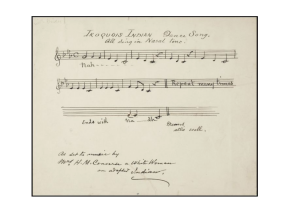The credibility and ethics of historical ethnographic work, especially in regards to the Indigenous communities of North America have been questioned next to modern standards. One of the more obvious examples of this is early ethnographers putting Native American songs to Western(Eurocentric) Notation. However, it wasn’t just ethnographers who studied Native American culture. The source below comes from the notes of an artist named Rufus Grider, who was not likely studying these people for ethnographic purposes or with ethnographic standards in mind(for better or worse). The notes study the Iroquois peoples who lived(and live now) mainly in the Northeastern region of the United States. Before looking at the music, Grider’s categorizes this song with “Iroquois” which earlier he includes the five tribes that are included under that label which include: The Mohawks(Grider clarifies that their official and proper name is “Caniegas”), Onidas, Onondagas, Cayugas, and The Senecas. He also describes and lists the dances he saw as well as his guesses on celebrations they were attached too, but here he titles it simply “Dance Song” 1. In connection to the music, one of the more curiously inaccurate aspects of this work is that it has a key signature(in what looks to be c minor) as the Indigenous peoples likely did not sing in accordance with western scales and keys. 
It is also possible that Rufus Grider was not the one who created this piece of sheet music as he attributes the work to an “H.M. Converse, a white woman, an adopted Indian” at the bottom of the piece. With further research it is found that this woman’s name is Harriet Maxwell Converse and the name she was given by the Seneca People(who adopted her) meant “Bearer of the Law” because she supported the Iroquois Convention 2
The purpose of Graider’s notes was likely for artistic interests or motivations but despite its clear inaccuracies, it is a good tool for people who are more familiar with western notation and who have not experienced the music or culture3(in addition to the fact that recording devices were not widely used in the late 1800’s when this source was written). If Converse had an intended audience, it would likely have been for audiences like these.
Footnotes:
1 Girder, Rufus A. Ms. Notes and Explanatory Text for Grider’s Artwork on Iroquois Indians]. New York, 1890. Accessed September 19, 2024. https://www.indigenoushistoriesandcultures.amdigital.co.uk/Documents/Detail/notes-and-explanatory-text-for-griders-artwork-on-iroquois-indians/7028348?item=7028361.
2 Merced County Sun, Volume XXI, Number 38, 19 June 1891. Merced County Sun 19 June 1891 – California Digital Newspaper Collection. Accessed September 19, 2024. https://cdnc.ucr.edu/?a=d&d=MCS18910619.2.47&e=——-en–20–1–txt-txIN——–.
3 Girder, Rufus A. Ms. Miscellaneous Items Relating to Iroquois Culture. New York, 1890. Accessed September 19, 2024. https://www.indigenoushistoriesandcultures.amdigital.co.uk/Documents/Detail/miscellaneous-items-relating-to-iroquois-culture/7028388?item=7028401.

Maria, this is super interesting. Grider is noteworthy, if not for his musical skills, as an exemplar of the times: his interest in Indian music was purely aesthetic, and his interest in the artistry of Native song was seemingly not accompanied by an interest in the context in which it was performed, the history of the practitioners, etc. Indeed, he seems to treat Converse as the “author” of this music for her role in notating it!
This is a well-written, and well-formatted blog post. I would just suggest breaking up that opening paragraph: an imposing block of text is not ideal for engaging the reader and quickly/concisely communicating your primary focus/thesis/argument.